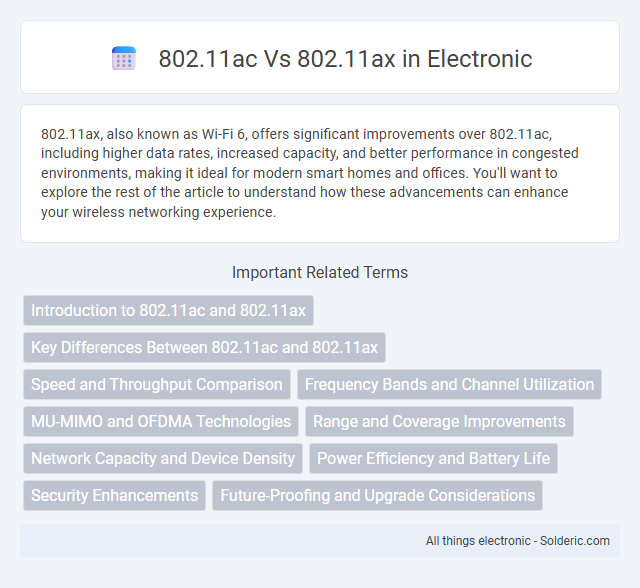802.11ax, also known as Wi-Fi 6, offers significant improvements over 802.11ac, including higher data rates, increased capacity, and better performance in congested environments, making it ideal for modern smart homes and offices. You'll want to explore the rest of the article to understand how these advancements can enhance your wireless networking experience.
Comparison Table
| Feature | 802.11ac | 802.11ax (Wi-Fi 6) |
|---|---|---|
| Release Year | 2013 | 2019 |
| Maximum Speed | Up to 3.5 Gbps | Up to 9.6 Gbps |
| Frequency Bands | 5 GHz only | 2.4 GHz & 5 GHz |
| Channel Width | 80 MHz (up to 160 MHz optional) | 20, 40, 80, 160 MHz |
| Modulation | 256-QAM | 1024-QAM |
| MU-MIMO Support | Downlink only | Uplink and downlink |
| OFDMA | No | Yes |
| Target Wake Time (TWT) | No | Yes (better power efficiency) |
| Backward Compatibility | 802.11a/b/g/n | 802.11a/b/g/n/ac |
| Primary Use Case | High-speed throughput in less congested environments | Optimized for dense environments and IoT devices |
Introduction to 802.11ac and 802.11ax
802.11ac, also known as Wi-Fi 5, offers high-speed wireless connectivity with maximum data rates up to 3.5 Gbps, operating primarily on the 5 GHz band to reduce interference and improve performance for streaming and gaming. 802.11ax, or Wi-Fi 6, enhances these capabilities by providing higher efficiency, increased capacity, and lower latency across both 2.4 GHz and 5 GHz bands, supporting speeds up to 9.6 Gbps. Your network benefits from improved device management and better performance in dense environments with Wi-Fi 6's advanced features like OFDMA and MU-MIMO.
Key Differences Between 802.11ac and 802.11ax
802.11ax, also known as Wi-Fi 6, offers higher data rates up to 9.6 Gbps compared to 802.11ac's peak of 3.5 Gbps by utilizing OFDMA technology and improved MIMO capabilities. Enhanced spectral efficiency in 802.11ax allows better performance in dense environments through features like Target Wake Time and BSS Coloring. In comparison, 802.11ac primarily operates in the 5 GHz band, while 802.11ax supports both 2.4 GHz and 5 GHz bands for improved coverage and reduced interference.
Speed and Throughput Comparison
802.11ax (Wi-Fi 6) offers significantly higher maximum speeds and improved throughput compared to 802.11ac (Wi-Fi 5), with 802.11ax reaching up to 9.6 Gbps versus 802.11ac's peak of 3.5 Gbps under ideal conditions. The introduction of technologies like OFDMA and MU-MIMO in 802.11ax allows your network to handle multiple devices simultaneously with greater efficiency and reduced latency. For environments congested with many connected devices, 802.11ax provides a noticeable performance boost, ensuring faster data transfer and more reliable Wi-Fi connections.
Frequency Bands and Channel Utilization
802.11ac operates primarily on the 5 GHz frequency band, offering wider channels up to 160 MHz for higher throughput but with limited ability to coexist in congested environments. In contrast, 802.11ax utilizes both 2.4 GHz and 5 GHz bands, incorporating OFDMA technology to divide channels into smaller resource units for improved efficiency and simultaneous multi-user communication. This advanced channel utilization in 802.11ax leads to reduced latency, better spectrum efficiency, and enhanced performance in dense network deployments compared to 802.11ac.
MU-MIMO and OFDMA Technologies
802.11ac supports MU-MIMO technology, allowing multiple devices to receive data simultaneously on the downlink, improving network efficiency for your wireless connections. In contrast, 802.11ax enhances MU-MIMO by enabling both uplink and downlink multi-user transmissions, while introducing OFDMA to divide channels into smaller resource units for concurrent device communication. These advancements in 802.11ax significantly boost network capacity and reduce latency compared to 802.11ac.
Range and Coverage Improvements
802.11ax, also known as Wi-Fi 6, offers significant range and coverage improvements over 802.11ac by utilizing technologies such as Orthogonal Frequency Division Multiple Access (OFDMA) and Target Wake Time (TWT). These advancements enable more efficient data transmission, reduced latency, and better performance in dense environments, extending effective coverage. Enhanced spatial reuse and uplink/downlink scheduling in 802.11ax improve signal quality and reliability, resulting in broader coverage compared to the 802.11ac standard.
Network Capacity and Device Density
802.11ax, also known as Wi-Fi 6, significantly improves network capacity and device density compared to 802.11ac by utilizing OFDMA (Orthogonal Frequency Division Multiple Access) and MU-MIMO technologies, enabling simultaneous data transmission to multiple devices. This results in more efficient spectrum use and reduced latency in environments with many connected devices, such as offices or public hotspots. The increased capacity supports up to four times more concurrent users, making 802.11ax ideal for high-density scenarios unlike 802.11ac, which is limited by its narrower channel access methods.
Power Efficiency and Battery Life
802.11ax, also known as Wi-Fi 6, significantly improves power efficiency compared to 802.11ac through features like Target Wake Time (TWT), which schedules when devices wake to send or receive data, reducing unnecessary power consumption. This enhancement extends your battery life by minimizing active time and optimizing data transmission intervals. Devices using 802.11ax can maintain longer operational periods on a single charge, making it ideal for mobile and IoT applications requiring efficient energy use.
Security Enhancements
802.11ax (Wi-Fi 6) introduces advanced security enhancements over 802.11ac, including mandatory support for WPA3, which provides stronger encryption and improved protection against brute-force attacks. The improved encryption protocols in 802.11ax also enhance data confidentiality and integrity through individualized data encryption for each user. These upgrades significantly reduce vulnerabilities in wireless networks, making 802.11ax the preferred choice for secure Wi-Fi environments.
Future-Proofing and Upgrade Considerations
802.11ax, also known as Wi-Fi 6, offers superior future-proofing compared to 802.11ac by supporting higher data rates up to 9.6 Gbps, improved spectral efficiency, and better performance in congested environments. Its advanced features like OFDMA, MU-MIMO, and Target Wake Time (TWT) ensure enhanced network capacity, lower latency, and extended battery life for connected devices. Upgrading to 802.11ax provides long-term benefits by accommodating the increasing number of IoT devices and high-bandwidth applications typical of smart homes and enterprise networks.
802.11ac vs 802.11ax Infographic

 solderic.com
solderic.com